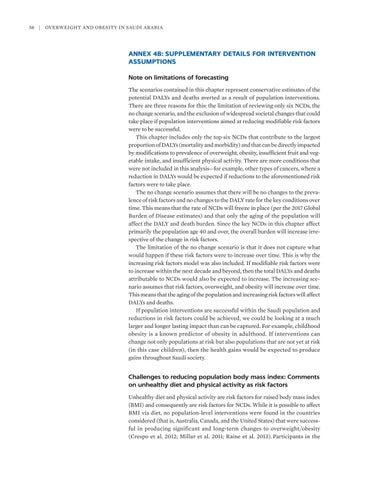58
|
Overweight and Obesity in Saudi Arabia
ANNEX 4B: SUPPLEMENTARY DETAILS FOR INTERVENTION ASSUMPTIONS Note on limitations of forecasting The scenarios contained in this chapter represent conservative estimates of the potential DALYs and deaths averted as a result of population interventions. There are three reasons for this: the limitation of reviewing only six NCDs, the no change scenario, and the exclusion of widespread societal changes that could take place if population interventions aimed at reducing modifiable risk factors were to be successful. This chapter includes only the top six NCDs that contribute to the largest proportion of DALYs (mortality and morbidity) and that can be directly impacted by modifications to prevalence of overweight, obesity, insufficient fruit and vegetable intake, and insufficient physical activity. There are more conditions that were not included in this analysis—for example, other types of cancers, where a reduction in DALYs would be expected if reductions to the aforementioned risk factors were to take place. The no change scenario assumes that there will be no changes to the prevalence of risk factors and no changes to the DALY rate for the key conditions over time. This means that the rate of NCDs will freeze in place (per the 2017 Global Burden of Disease estimates) and that only the aging of the population will affect the DALY and death burden. Since the key NCDs in this chapter affect primarily the population age 40 and over, the overall burden will increase irrespective of the change in risk factors. The limitation of the no change scenario is that it does not capture what would happen if these risk factors were to increase over time. This is why the increasing risk factors model was also included. If modifiable risk factors were to increase within the next decade and beyond, then the total DALYs and deaths attributable to NCDs would also be expected to increase. The increasing scenario assumes that risk factors, overweight, and obesity will increase over time. This means that the aging of the population and increasing risk factors will affect DALYs and deaths. If population interventions are successful within the Saudi population and reductions in risk factors could be achieved, we could be looking at a much larger and longer lasting impact than can be captured. For example, childhood obesity is a known predictor of obesity in adulthood. If interventions can change not only populations at risk but also populations that are not yet at risk (in this case children), then the health gains would be expected to produce gains throughout Saudi society.
Challenges to reducing population body mass index: Comments on unhealthy diet and physical activity as risk factors Unhealthy diet and physical activity are risk factors for raised body mass index (BMI) and consequently are risk factors for NCDs. While it is possible to affect BMI via diet, no population-level interventions were found in the countries considered (that is, Australia, Canada, and the United States) that were successful in producing significant and long-term changes to overweight/obesity (Crespo et al. 2012; Millar et al. 2011; Raine et al. 2013). Participants in the






